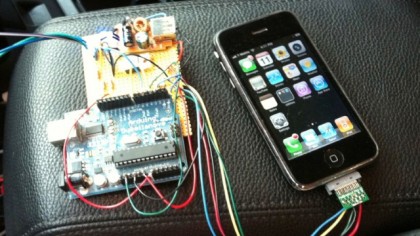The secret lives of gadgets: 10 crazy uses for your tech
Innovative ideas that probably invalidate the warranty

Want to know what a gadget can do? Don't ask the manufacturers: they're the last people to find out. History is littered with examples of devices that took on a whole new life without the manufacturers' involvement: the inventors of SMS thought it'd be used purely by phone engineers, the Microplane graters used for parmesan were originally designed for planks and Pay As You Go phones were never designed to make criminals' communications harder to intercept.
So what other gadgets have secret lives that their creators probably didn't expect? Here are our favourites.
1 The twisted car starter

Ever felt that starting your car was just too low tech? Will O'Brien has the answer: an iPhone-controlled starting system that fires up the engine when you send your car a text. It's based around an old Arduino board, an equally old jailbroken iPhone and a knackered old iPhone car charger, and you'll find the instructions on making your own one here.
Just make sure you get the right schematic: there's a small error on the first one, although as O'Brien says "it's not lethal, just important".
2 The VHS video toaster
Older readers will remember the anarchic 80s sitcom The Young Ones, whose video recorder famously didn't show films but did make a lovely piece of toast. That was the inspiration for the VHS Video Toaster, which involves sacrificing a perfectly good if rather ugly toaster and which is almost certainly a fire hazard.
3 The USB typewriter
We love this one: Jack Zycklin takes old typewriters and turns them into fully functional keyboards for PCs, iMacs and even iPads. If like us you're the kind of person who needs to work on computers or tablets but lusts after old Underwoods, the USB Typewriter pages will have you drooling - although if you work in a shared office it might not be the best idea to stick one on your work PC.
4 The point and shoot plant inspector
Public Laboratory has been turning ordinary point and shoot cameras into near-infrared cameras, which can monitor plants to see how healthy they are by detecting how much photosynthesis is happening: the technique can identify plants that need additional care, and even whether they're stressed. If the thought of cannibalising an old Canon makes you nervous, there's also a Kickstarter to fund off-the-shelf devices you can order online.
Sign up for breaking news, reviews, opinion, top tech deals, and more.
5 The perfectly printed murder machines
"It's the next industrial revolution!", said the 3D printing firms. "Woo! We can make guns with it!" said people who like guns. 3D printed guns are firmly in the dangerous toy category at the moment - you're more likely to hurt yourself than do serious damage to anybody else with one - but it's clear that like most exciting tech, 3D printing could have plenty of negative uses as well as positive ones.
6 The Kinect internal inspector
Hacked Kinect sensors are useful medical tools, enabling researchers to see what's inside people's heads, and they can be teamed up with CT scans to create a "magic mirror" that enables you to look at your own bones. The PC version of Kinect has proven particularly attractive to the hacking community, and it's been used to control musical instruments and music software, display and navigate through all kinds of 3D imagery and control terrifying robots.
7 The smartphone satellite
We're pretty sure "going into space" wasn't in Google's plans for its Nexus smartphones, but the UK STRaND-1 satellite went into orbit earlier this year with a Nexus One at its heart. It isn't just the first smartphone-powered satellite, though. Its makers reckon it's the first satellite to take a 3D-printed part into space too.
8 The big-screen phone charger

It's definitely not recommended by the manufacturers - and if the port is just a service port rather than for USB devices and flash drives it may well brick your TV - but if your TV has a spare USB port you can use it to charge your devices. Don't expect high-speed charging, though, and in most cases you'll need to keep the TV on or the ports won't be powered up.
9 The router that runs your home
Arpad Toth is much smarter than we'll ever be: he's found a way to turn a cheap router into a home automation server that you can control with an iPhone or iPad. The router runs a web server, and when you hit a button the command is routed via an Arduino-style board that converts it to an RF signal. That signal then goes to RF-enabled plug sockets and devices.
10 The Android babysitter

Got an old Android phone kicking about? Don't chuck it: install an app such as IP Cam Viewer Lite, get a cheap Wi-Fi security camera from eBay and you'll be able to spy on your children; go for IP Webcam and the phone becomes the camera and you can access it from somewhere else. Alternatively you could run it as a server with an app such as Servers Ultimate, or install an emulator to turn it into an old-school games console.

Contributor
Writer, broadcaster, musician and kitchen gadget obsessive Carrie Marshall has been writing about tech since 1998, contributing sage advice and odd opinions to all kinds of magazines and websites as well as writing more than twenty books. Her latest, a love letter to music titled Small Town Joy, is on sale now. She is the singer in spectacularly obscure Glaswegian rock band Unquiet Mind.